The Seventeenth USA ARDF Championships
and Ninth IARU Region 2 ARDF Championships
Near Cincinnati, Ohio, July 31 - August 6, 2017
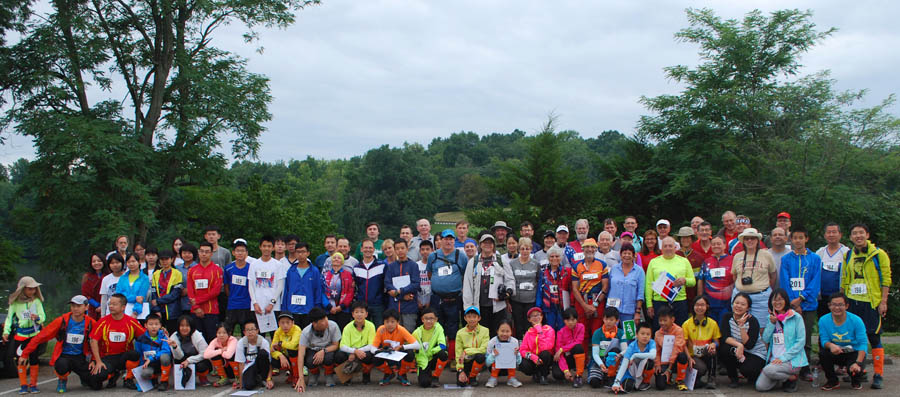
Competitors and volunteers just before the start of the 80-meter classic event. (Click photo for larger version.)
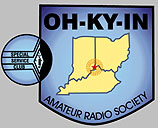
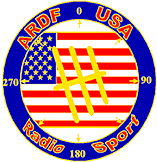 They came from all over the USA plus Australia, Canada, Germany and Ukraine. They ranged in age from 13 through 75. They took to the courses with eagerness and many went home with medals. The 17th USA Championships of Amateur Radio Direction Finding (ARDF) had something for everyone.
They came from all over the USA plus Australia, Canada, Germany and Ukraine. They ranged in age from 13 through 75. They took to the courses with eagerness and many went home with medals. The 17th USA Championships of Amateur Radio Direction Finding (ARDF) had something for everyone.
Long time fans of the sport, which is also called foxtailing and radio-orienteering, were treated to challenging courses, set by experts. Beginners had the opportunity to learn and practice the nuances of every event. Everyone had the chance to greet old radio-orienteering friends and to make new ones.
This was the third time that hams of the Cincinnati area have hosted USA's championships. Every time, it has gone more smoothly and participants have had more fun. The OH-KY-IN Amateur Radio Society was primary sponsor, bringing together volunteer hams of the tri-state area. Additional helpers were members of Orienteering Cincinnati (OCIN), which also provided the excellent course maps.
Classic orienteering is a popular sport in the Cincinnati area, in part because there are many forests that are ideal for map-and-compass sports. This made it possible for 2017's competitive events and practice sessions to be in locations that have never been used for championship ARDF in the past. The 2017 USA championships were combined with the ninth championships of International Amateur Radio Union (IARU) Region 2, which encompasses North and South America.
A Gateway Sport for Kids
You have heard and read it many times: "We need to get more young people involved in ham radio activities." In some parts of China, that is being done in a big way. Guangzhou No. 2 High School in southern China has been a center of excellence for ARDF for several years. As a part of the physical education program, every student experiences it and the ones who do well are given the opportunity to compete around the world.
In 2015, over fifty students from the school came to Elbert, Colorado for the USA and IARU Region 2 championships. Also that summer, another group from the school attended the IARU Region 3 championships in Gunma, Japan. In 2016, a large group ran in the ARDF World Cup events in Bulgaria. The school has just announced a partnership with ARDF Team Ukraine, one of the best in the world, for ongoing training and competitions.
So it was no surprise when leaders of the school's ARDF program asked to bring students to the 2017 championship courses in Ohio. The group first traveled to Asheboro, North Carolina on July 24 for four days of training organized by Joseph Huberman K5JGH and Ruth Bromer WB4QZG of Backwoods Orienteering Klub. Joseph and Ruth's home is on the edge of a well-mapped forest, so most of the courses started and ended in their back yard.
The first day was a workshop on map-reading, bearing-taking and plotting. The following days were practice in the four major ARDF events: foxoring, sprint, two-meter classic and 80-meter classic. After that, the Chinese kids departed to do some sightseeing on the way to Ohio for the championships.
Training was also an important feature of the championships in Ohio. On July 31, a mix of about twenty beginning and experienced radio-orienteers gathered at Green Township Veterans Park in Georgetown for a short two-meter course in the park and on the grounds of nearby Diamond Oaks High School. First timers such as Fred Mailey, K8FCM got a chance to get tips from veteran ARDF Team USA members such as Leszek Lechowicz, NI1L.
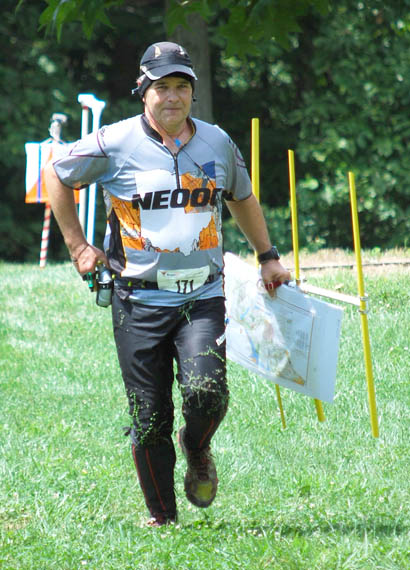
Fred Mailey K8FCM of the Northeast Ohio Orienteering Club experienced competitive ARDF for the first time at the 2018 USA championships.
Among the foreign visitors this day were three from Australia: Ewen Templeton VK3OW, Jenelle Templeton VK3FJTE and Jack Bramham VK3WWW. Jack is a big fan of training sessions. Afterward, he wrote in a blog to his friends back home: "Each session was on a real map and various terrains using the actual event transmitters. So we were able to get a real feel for what we are to face when the competition starts.
"Having the training sessions has made a difference to the friendliness of the meet," Jack continued. "With the training those who attend seem to form a nice bond with each other and that will continue through the event and follow on to future events."
The second training day was at Pyramid Hill Sculpture Park in Hamilton, Ohio. Adding to the difficulty was the park's very hilly terrain. This was a shortened 80-meter course with classic transmitter timing. Each of the five foxes was on for one minute in rotating sequence. For fairness, competitors in ARDF are started in small groups just as the first fox comes on the air.
Most of USA's casual on-foot foxhunters aren't familiar with 80-meter ARDF, but it has become very important because three of the four international events take place on that band. On this day, several trainees got their first opportunity to try out the newest and most sophisticated 80-meter receiver/antenna assemblies. Several competitors took to the Ohio courses with sets by Vadim Afonkin KB1RLI, who was there to give pointers. Also present for the week were Nick Roethe DF1FO, designer of the RF and digital circuits in the new FoxRex 3500, as well as Oleg Shuman UT5UML, the engineer for Rig Expert in Ukraine who is in charge of production for it.
Wednesday, the last training day, featured two events at William Harbin Park in Fairfield, Ohio. In the morning was the sprint, an 80-meter event with two five-fox short courses, each course on a different frequency with twelve-second transmissions to give a complete cycle every minute. The FoxRex 3500 is becoming popular for the sprint because it has four memories for quick switching among the two fox frequencies and two beacon frequencies.
The afternoon was devoted to foxoring, a hybrid of orienteering and RDF in which competitors receive a map marked with about ten small circles. They are to orienteer their way to the location represented by each circle and find the transmitter somewhere therein. The foxes run very low power and often cannot be heard outside their circles. As always in ARDF, scoring is first by number of foxes found and second by elapsed start-to-finish time. For all of the training sessions, there were no distinctions made for age and gender. Everyone was encouraged to find all transmitters.
Many more competitors arrived in the headquarters city of Harrison, Ohio in time for the first formal event on Thursday, including all of the Chinese youth. The Thursday event, a sprint, was 26 miles away at England-Idlewild Park in Burlington, Kentucky. Course designers and setters for Thursday and Friday were Bob Frey, WA6EZV and Dick Arnett, WB4SUV, who had also designed all of the practice courses.
For this and all of the remaining events, there was strict adherence to IARU rules. Competitors' receiver sets were impounded upon arrival each morning. They could not pick them up until two cycles before their start times and could not turn them on until they set out on the course. Each competitor was in one of fifteen age/gender categories, so 13-year-old girls were not competing for the same medals as 75-year-old men. Those in each category were told which of the transmitters they were required to find.
The championship events were scored electronically. Each person carried a SportIDENT RFID tag that he or she dipped into an electronic control box at the start, finish and each fox. After crossing the finish line, competitors downloaded their tags and immediately received a printout of their elapsed times, as well as times to find each required fox.
On Friday, everyone traveled to Mitchell Memorial Forest in Cleves, Ohio for the foxoring championships. There were nine QRP transmitters in these hilly woods. The number of required foxes ranged from four for W13 and W16 (1.9 km course) to nine for M21 and W21 (3.0 km). Most participants found all required foxes and nobody went over the two-hour time limit.
Even though some participants had already experienced five days of strenuous ARDF, the longest and hardest events were yet to come. These were the classic courses on two meters and 80 meters, set by Brian DeYoung K4BRI and Matthew Robbins AA9YH in the 4000-acre Miami Whitewater Forest. The two-meter course on Saturday morning was south and east of the High Plains Shelter, which was the finish area on both days.
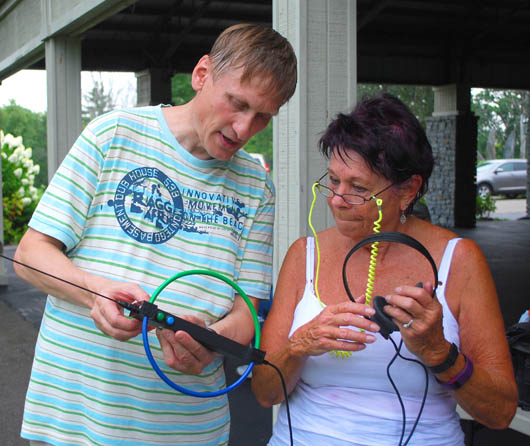
Oleg Shuman UT5UML is the engineer for Rig Expert in Ukraine who adapted the Nick Roethe DF1FO 80-meter ARDF set design into the FoxRex 3500. Here he explains its operation to Pat Maley, KD8PAT.
Starters were divided into groups with no two persons in the same category in a group. Start times were at five-minute intervals corresponding to the start of Fox #1 transmissions. So it took almost two hours to get everyone onto the course. Optimum route lengths for start to each required fox and then to the finish ranged from 3.1 km for M13 and W13 (two required foxes) to 7.1 km for M21 (all five foxes).
The two-meter classic course is always the most difficult because of VHF signal blockage and reflection by the hills. However, everyone finished before the 3-1/2 hour time limit and a few had amazingly good times. Bob Cooley KF6VSE, age 74, found three of his required transmitters in 1:02:10. In M40, Vadim Afonkin KB1RLI, tagged four required foxes in 1:09:39 and in M21, Illia Ivanko of Ukraine got all five in 1:09:26.
Food and Medals
Harrison's chapter of the American Legion hosted the traditional awards banquet on Saturday evening, where medals were presented for sprint, foxoring and two-meter classic. These ceremonies are unlike the World Championships, where there are podiums of different heights for gold, silver and bronze medalists, as well as playing of national anthems. Instead, USA's championship organizers simply call up the winners to stand before the applause of the audience and the flashing of cameras. With three events, fifteen categories in each and two divisions (IARU Region 2 and visitors), over 200 medals were given out.
The clouds were thick on Sunday morning as everyone returned to Miami Whitewater Forest for the 80-meter classic. No sunscreen was needed this day! This time, the courses were east, north and west of the finish shelter. The start was 1.5 km northeast near the docks for the lake. In accordance with IARU rules, there were no foxes within 700 meters of the start and 400 meters of the finish.
Light rain began falling as the first group left the start and by the time the last group had begun, there was a steady downpour. Fortunately, organizers had sealed the maps in plastic bags. Most runners also had placed protective bags over their receivers.
The two-meter and 80-meter classic events were scored with FjwW software, which provided each competitor with a printout of route as well as fox times. It also gave an audio greeting to each incoming runner that included elapsed time and standing in category so far. Course lengths ranged from 2.7 km for M13 and W13 to 5.7 km for M21, W21, M40 and M50.
Despite the rain, almost everyone did better on 80 meters. Few were out more than three hours. Illia Ivanko had the best five-fox time again that day, finding them in just 1:02:05. Once everyone has accounted for and the box lunches were all consumed, it was time to give out the medals for this band and then for everyone to say farewell.
The annual USA ARDF Championships play an important role in filling the roster of ARDF Tam USA for the ARDF World Championships, which take place in even-numbered years. Each nation may field up to three competitors in each of the age/gender categories. IARU rules state that to be on a nation's team, one must be a citizen of that nation or have resided there legally for at least one year.
Taking first place awards among the USA-eligible competitors, in alphabetical order, were Vadim Afonkin KB1RLI (M40 2m, 80m, foxor), Natalia Bondarenco (W35 2m, 80m, sprint), Ruth Bromer WB4QZG (W60 2m, 80m, sprint, foxor), Thomas Chen (M16 2m, 80m), Bob Cooley KF6VSE (M70 2m, 80m, sprint, foxor), Jay Hennigan WB6RDV (M60 sprint), Joseph Huberman K5JGH (M60 2m, 80m, foxor), Mengbing Li (W21 2m, 80m, sprint, foxor), Nicolai Mejevoi (M50 2m, 80m, sprint, foxor), Alla Mezhevaya (W35 2m, foxor), Eduard Nasybulin (M21 2m, 80m, sprint, foxor), Kelly Sears (W50 2m, 80m, sprint, foxor), Evghenii Vorsin KD2MZT (M40 sprint), Jenny Wang (W16 2m, sprint, foxor) and Amy Wang (W19 2m, sprint, foxor).
Many thanks to Bob, Dick, Matt and Brian for their hours of work in preparing and executing these championships. Many other volunteers helped with transmitter placement, start-finish line operations and other logistics roles, including Mike Minium of Orienteering Cincinnati, Terry Boyle NF8B and Don Ferneding N8LMJ. April Moell WA6OPS and Claudia Pitchford N9HHE handled lots of sprains and scrapes at the finish line.
Click for seven pages of photos in this Homing In site.
Here are links to the official results.
Sprint results, Thursday, August 3
Foxoring results, Friday, August 4
Two-meter classic results, Saturday, August 5
Eighty-meter classic results, Sunday, August 6
Portions of this report have been excerpted from my Homing In column in the November 2017 issue of CQ Amateur Radio magazine.
Joe Moell KØOV
USA ARDF Coordinator
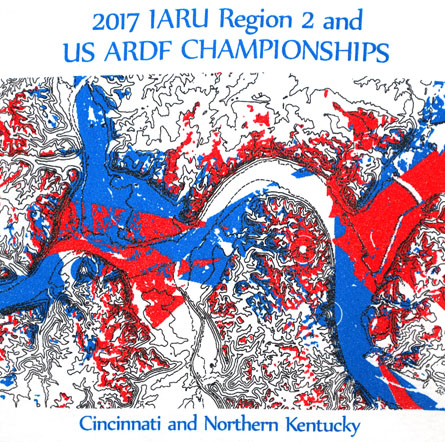
Text and photos copyright © 2017 Joseph D. Moell. All rights reserved.
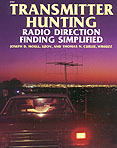 Go to First photo page of this event
Go to First photo page of this event
Go to Championships Foxhunting News -- Recent and upcoming ARDF championships events
Go to International-Style Foxhunting Comes To The Americas -- How we're getting the ball rolling
Go to Equipment Ideas for Radio-Orienteering -- Simple and inexpensive receiving and transmitting solutions
Go to Radio-Orienteering News for Southern California -- Results and stories of recent radio-orienteering events in southern California, plus announcements of upcoming ones.
Go to Foxhunting for Scouts -- Let's get the kids involved
 Back to the Homing In home page
Back to the Homing In home page
This page updated 27 November 2019


 They came from all over the USA plus Australia, Canada, Germany and Ukraine. They ranged in age from 13 through 75. They took to the courses with eagerness and many went home with medals. The 17th USA Championships of Amateur Radio Direction Finding (ARDF) had something for everyone.
They came from all over the USA plus Australia, Canada, Germany and Ukraine. They ranged in age from 13 through 75. They took to the courses with eagerness and many went home with medals. The 17th USA Championships of Amateur Radio Direction Finding (ARDF) had something for everyone.




